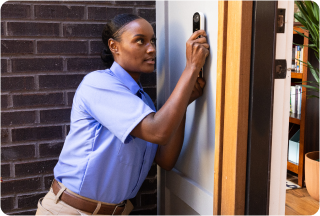Ignore, Repair or Replace? What to Do When Your Doorbell Doesn’t Work

Ding dong! We only think of the doorbell when it rings, but what to do if it doesn't work? Do you replace it? Can you fix it yourself? AHS has the answers!


Ding dong! We only think of the doorbell when it rings, but what to do if it doesn't work? Do you replace it? Can you fix it yourself? AHS has the answers!
The doorbell — this often ignored feature of your home — is probably the last thing on your mind to be repaired when it comes to the bigger issues around the house. If you have a lot of visitors or receive a lot of deliveries, however, this feature gets a quite a bit of use. What happens when it begins to malfunction, and eventually, your doorbell doesn’t work at all anymore? Is it costly to repair or replace? Should it be handled by a professional?
Common Broken Doorbell Causes
First, let’s assess the problem. The most common doorbell issues include:
Learn how a protection plan can help keep your doorbell in working order.

How to Replace Doorbell Components Yourself
It’s certainly more cost-effective to know how to install a doorbell yourself, especially if you’re looking to replace it with a basic wired style. In fact, buttons by themselves can be as cheap as $10, while kits with a button and chime box start at around $15. Simply attach the existing wires to the screws of the new component(s), just like the old component(s) were attached — following the manufacturer’s instructions, of course. Simple, right?
If you want to skip the wires altogether, consider installing a wireless doorbell according to the manufacturer’s instructions instead. Because it is wireless, however, you will have to change the batteries occasionally.
When to Enlist an Expert
If your issue is with a broken transformer or faulty wiring, your best — and safest — bet is to call a professional who knows how to fix doorbells. Although the cost could range from around $200 to $350, you can rest assured that the job will be done correctly and according to electrical code.
Want to avoid the Inspector Gadget/DIY route and let the professionals handle it from the start? You’ll be pleasantly surprised to know that this small, often neglected (yet useful) device is likely covered under your home warranty. It's certainly covered by American Home Shield. You're welcome.
AHS assumes no responsibility, and specifically disclaims all liability, for your use of any and all information contained herein.
Have a plan for your home when things don't go according to plan
Shop Home Warranties